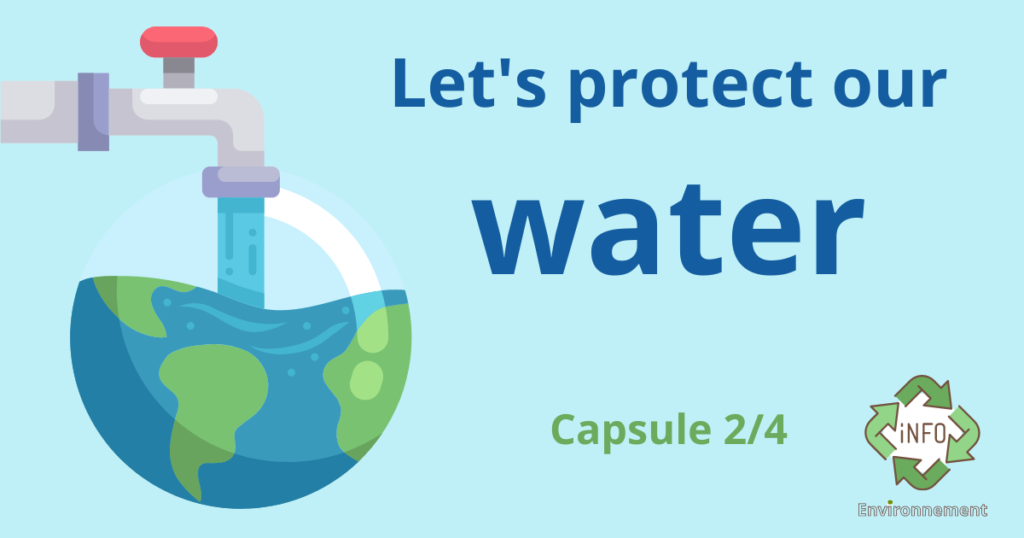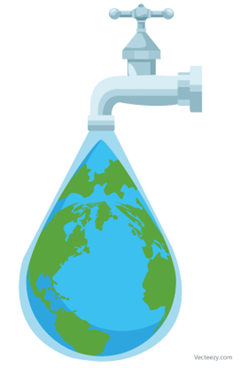Drinking water in Sutton (#2 of 4) – Residential and commercial use and consequences of overuse
The Environmental Advisory Committee (EAC) of the Town of Sutton presents a series of 4 information capsules on the theme of drinking water, its availability, its management and its sustainable use. For this second capsule, we present how our drinking water is used and what are the consequences of an overuse of this resource.

Use of drinking water
In the first capsule on drinking water, we saw that residential consumption in Sutton is estimated at 344 liters per person per day in 2022.
According to data on indoor residential water use presented by the Ministère des Affaires municipales et de l’Habitation (MAMH), toilets are the largest source of water consumption (24%), followed by showers (20%) and taps (19%).

Numbers worth thinking of
According to rough calculations by MAMH*, it is estimated that we use:
- 464 liters/person/week for toilets (at standard flow)
- 519 litres/person/week for showers (at 1 shower per day)
- 349 liters/person/week for brushing teeth (by letting the water run continuously)
This does not include other residential water uses such as dishwashing, hand washing, clothes washing and cooking.
In addition, drinking water consumption can double during the summer because of outdoor uses such as watering plants, washing vehicles and buildings, swimming pools, etc., which can account for up to 30% of total domestic water consumption (source: City of Granby).
Commercial Uses
In Sutton, the uses of drinking water (from aqueducts or wells) by businesses are diverse. Aside from toilets and the provision of drinking water, these uses include:
- Hotels and inns: swimming pools, spas, room cleaning, kitchens
- Restaurants: food preparation, dishwashing, cleaning
- Microbreweries: beer production, equipment washingExcavators: washing of company vehicles
- Nurseries: irrigation of plants
In addition, a major source of drinking water consumption in some businesses is the use of water-cooled refrigeration systems without a recirculation loop. These types of cooling systems can consume thousands of liters of water per year.
Consequences of overuse of drinking water
Even if there is a perception of abundance and free water among Quebecers, the management of drinking water is complex. Producing drinking water and treating wastewater generates significant costs for municipalities and, by extension, for citizens.
Among the many consequences of overuse of drinking water are:
- Excessive pressure on surface and groundwater sources
- Water withdrawals must be balanced with the recharge capacity of the lakes and aquifers that supply it and the ecosystems that depend on them;
- Water supplies are not constant and predictable and can vary greatly from year to year. Climate change is making the limits of this resource more and more apparent.
- Increased operating and capital costs
- Excessive consumption of drinking water leads to increased costs to collect, store, treat and distribute drinking water, not to mention the accelerated wear and tear on the sometimes-aging infrastructure;
- In addition, all of this drinking water, once used, becomes “waste” water that must be treated before being released into the environment. The increase in the volume of water to be treated also leads to additional costs.
- Increased costs to citizens
- Increased water infrastructure and treatment needs result in higher water and wastewater rates and taxes for citizens;
- Some citizens who rely on wells for their water may find themselves without water during certain periods.
- The delivery of a trip of water by tanker truck can cost up to $500, not to mention the related greenhouse gas emissions.
- Constraints to development
- Lack of water limits the possibility of building in certain areas
Water Saving Tip of the Week

Toilet use is the largest source of indoor water consumption in your home, but it also represents an excellent water saving potential.
Replace your standard toilet with a WaterSense certified or low-flow toilet that can reduce drinking water use by up to 60%. A household of four can save over 60,000 liters a year with this small action.
Fixing a leaky toilet will also prevent large volumes of water from being wasted. A leaking toilet uses up to 550 liters of drinking water per day, which can double your daily water consumption. Some leaks make a noise that can be heard, but others are silent. To determine if a toilet is leaking, put two or three drops of food coloring in the tank. If the water in the bowl turns color after a few minutes, there is a leak. Most of the time, a leak can be repaired at low cost. (Source: MAMH)

Sources:
MAMH, Campaign Mon empreinte bleue, https://www.mamh.gouv.qc.ca/infrastructures/campagne-mon-empreinte-bleue/
City of Granby, https://granby.ca/fr/subvention-baril
Guide L’économie d’eau potable et les municipalités – Volume 1, Réseau Environnement, https://reseau-environnement.com/wp-content/uploads/2021/12/ECO_EA1.pdf
